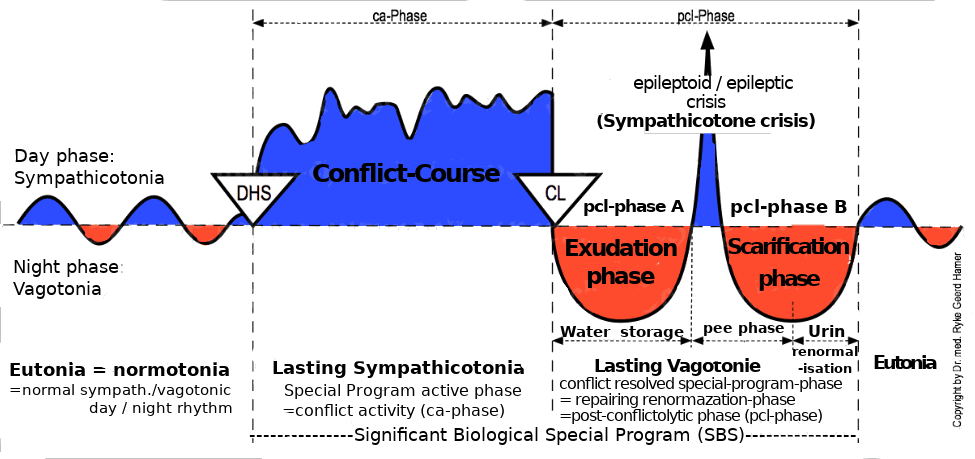Brainstem = Old Brain = Inner Germ Layer = Endoderm

Small Intestine Carcinoma Upper Part – Diagnostic Chart
Conflict, not being able to digest a morsel, indigestible anger.
Usually, the conflict has the added aspect of starvation.
–
HH in the brainstem (pons), ventro-lateral (inferior-lateral) on the right side
The entire small intestine (jejunum and ileum) of 23 feet in length corresponds to a relay in the brain, otherwise provided for about 3.3 feet. The small intestine has grown developmentally very rapidly in a short time. Therefore, the flat growing small intestine adeno-Ca of the absorptive quality is widely spaced and consists of only a few intestinal cylinder epithelium-Ca layers. Therefore, mechanical ileus by the Ca rarely occurs here.
The typical intestinal tumor in the process of degradation due to tuberculous-caking necrotization may or may not bleed. In contrast, the jejunum-Ca practically always bleeds. Bleeding mucosal fragments and mucus are shed and excreted in the feces. Until now, we had always considered such healing phases (Crohn’s disease, ileitis) as a separate disease. The shedding of bloody mucus and mucus-producing cylinder epithelium, which we have previously understood as a disease (Crohn’s disease), has in each case been only the healing phase (with or without TBC). The conflict-active phase, in which we were asymptomatic and believed ourselves healthy, was actually the tumor growth.
Centralization
Active phase
Food or morsel resorption, similar to the starvation conflict, to avoid starvation.
–
Copyright © 2024 by GHk Online Service, LLC
| Cookie | Duration | Description |
|---|---|---|
| cookielawinfo-checkbox-analytics | 11 months | This cookie is set by GDPR Cookie Consent plugin. The cookie is used to store the user consent for the cookies in the category "Analytics". |
| cookielawinfo-checkbox-functional | 11 months | The cookie is set by GDPR cookie consent to record the user consent for the cookies in the category "Functional". |
| cookielawinfo-checkbox-necessary | 11 months | This cookie is set by GDPR Cookie Consent plugin. The cookies is used to store the user consent for the cookies in the category "Necessary". |
| cookielawinfo-checkbox-others | 11 months | This cookie is set by GDPR Cookie Consent plugin. The cookie is used to store the user consent for the cookies in the category "Other. |
| cookielawinfo-checkbox-performance | 11 months | This cookie is set by GDPR Cookie Consent plugin. The cookie is used to store the user consent for the cookies in the category "Performance". |
| viewed_cookie_policy | 11 months | The cookie is set by the GDPR Cookie Consent plugin and is used to store whether or not user has consented to the use of cookies. It does not store any personal data. |
You’ll be informed by email when we post new articles and novelties. In every email there is a link to modify or cancel your subscription.